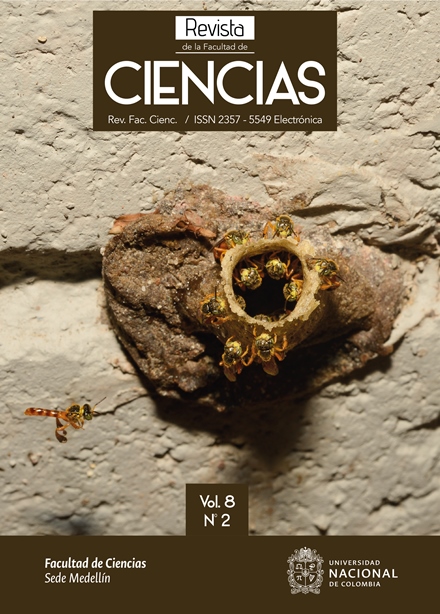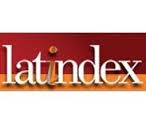Carta de control T de ARL insesgado con parámetro estimado
ARL unbiased control T chart with estimated parameter
DOI:
https://doi.org/10.15446/rev.fac.cienc.v8n2.69524Palabras clave:
ARL (longitud promedio de corrida), ARL insesgado, distribución exponencial, tiempo entre eventos (es)ARL (average run length), ARL unbiased, time between events, exponential distribution (en)
Descargas
Usualmente las cartas de control se construyen con estimaciones de los parámetros asociados a la distribucion de la variable o estadístico que se monitorea; sin embargo, se asume que estos son conocidos y en consecuencia, no se consideran los efectos que las estimaciones tienen sobre el desempeño de la carta.
En este trabajo se estudian los efectos de la estimación del parámetro de la carta t, la cual es usada para monitorear el tiempo entre eventos, asumiendo que esta variable sigue una distribucion exp(lambda_0). Para ello, se hizo un análisis inicial de la longitud promedio de corrida (ARL) cuando se usa un valor estimado para
este parámetro. El análisis preliminar permitió ver que la carta es de ARL sesgado; es decir, su ARL no es máxima cuando el proceso está en control. Además, se pudo mostrar que cuando lambda_0 es estimado, esta estimación afecta signicativamente la tasa de falsa alarma y la ARL cuando el tamaño de la muestra usada
para esta estimación es pequeña. En consecuencia, se estudian y proponen correcciones de los límites de control, con el fin de obtener una carta de ARL insesgado. Se consideró la construcción de límites de control con probabilidades de colas con valores nominales iguales y diferentes y se trabajó con dos criterios de optimización en cada caso, en el primero se hallaron correcciones tales que la carta fuera de ARL insesgado y su valor en control igual a una cantidad deseada; en el segundo criterio, además de buscar correcciones
para lograr una carta de ARL insesgado, se buscó alcanzar una tasa de falsa alarma deseada. Los resultados sugieren que cuando se corrigen los límites, es mejor fijar la ARL en lugar de la tasa de falsa alarma, sin embargo, es indiferente denir los límites con colas nominales de igual o distinta probabilidad, de la misma forma, resulta indiferente la elección de uno u otro estimador entre los dos que fueron considerados en este artículo.
The control charts are usually constructed with estimates of the parameters associated to the distribution of the variable or statistic being monitored; however, it is assumed that these parameters
are known, and therefore the efects that estimates have on the performance of the chart are disregarded. This paper studies the eects of the estimation of the parameter of the chart t, which is used to monitor the time between events, assuming that this variable follows a distribution exp(lambda_0). For this, an initial analysis of the average run length ARL for the chart was made when lambda_0 is an estimated value for this parameter. The preliminary analysis showed that the chart in either case is not of ARL unbiased, it means that its ARL is not maximized when the process is in control. In addition, it was shown that when lambda_0 is estimated, this estimation afects signicantly the false alarm rate and the ARL when the sample size used for this estimation is small. Consequently, corrections to the limits of control are studied and proposed in order to obtain a chart of ARL unbiased. The construction of limits were considered with probabilities of tails with equal and diferent nominal values, two optimization criteria were taken into consideration in each case, in the first criterion, corrections were found such that the chart be of ARL unbiased and also the ARL in control satisfying a desired value; in the second criterion, not only looked for corrections to achieve an unbiased
ARL but also sought to achieve a desired false alarm rate. The results suggest that when estimating the parameter and correcting the limits, it is better to set the ARL instead of the false alarm rate, however, it is irrelevant to dene the limits with probabilities of tails with equal nominal values or dierent, in the same way, the choice of one or another estimator among the two that were considered in this article is indiferent.
Referencias
Aslam, M., Azam, M. & Jun, C.-H. (2015). A new control chart for exponential distributed life using ewma., Transactions of the Institute of Measurement and Control 37(2), 205–210. DOI: 10.1177/0142331214537293.
Borror, C. M., Keats, J. B. & Montgomery, D. C. (2003). Robustness of the time between events cusum, International Journal of Production Research 41(15), 3435–3444. DOI: 10.1080/0020754031000138321.
Calvin, T. W. (1983). Quality control techniques for zero-defects, IEEE Transactions on Components, Hybrids, and Manufacturing Technology 6(3), 323–328. DOI: 10.1109/TCHMT.1983.1136174.
Chakraborti, S. (2007),. Run length distribution and percentiles: The shewhart chart with unknown parameters., Quality Engineering, 19(2), 119 – 127. DOI: 10.1080/08982110701276653.
Chan, L. Y., Xie, M. & Goh, T. (2000). Cumulative quantity control charts for monitoring production processes, International Journal of Production Research 38(62) , 397–408. DOI: 10.1080/002075400189482.
Cheng, C.-S. & Chen, P.-W. (2010). An ARL-unbiased design of time-between-events control charts with runs rules, Journal of Statistical Computation and Simulation, 81(7), 857–871. DOI: 10.1080/00207543.2014.974848.
Goh, T. N. (1987). A control chart for very high yield processes, Quality Assurance, 13(1), 18–22.
Guo, B., Wang, B. X. & Xie, M. (2014). ARL-unbiased control charts for the monitoring of exponentially distributed characteristics based on type-II censored samples, Journal of Statistical Computation and Simulation, 84(12), 2734–2747. DOI: 10.1080/00949655.2014.898766.
Huang, S. & Yang, J. (2015). An ARL-unbiased design of gamma control chart, in ‘2015 First International Conference on Reliability Systems Engineering (ICRSE)’, pp. 1–6.
Jensen, W. A., Jones-Farmer, A., Charles, C. & Woodall, W. (2006). Effects of parameter estimation on control chart properties: A literature review, Journal of Quality Technology, 38(4), 349–364.
Khoo, M. B., Lee, M., Teoh, W., Liew, J. & Teh, S. (2013). The effects of parameter estimation on minimising the in-control average sample size for the double sampling X¯ chart, South African Journal of Industrial Engineering, 24(3), 58-67.
Kumar, N., Chakraborti, S. & Rakitzis, A. C. (2017). Improved shewhart-type charts for monitoring times between events, Journal of Quality Technology, 49(3), 278–296. DOI: 10.1080/00224065.2017.11917995.
Montgomery, C. D. (2007). Introduction to statistical quality control, John Wiley & Sons.
Ozsan, G., Testik, M. C. & Weiβ, C. H. (2010). Properties of the exponential EWMA chart with parameter estimation, Quality and Reliability Engineering International, 26(6), 555–569. DOI: 10.1002/qre.1079.
Psarakis, S., Vynioua, A. K. & Castagliola, P (2014). Some recent developments on the effects of parameter estimation on control charts, Quality and Reliability Engineering International, 30(8), 1113-1129. DOI: 10.1002/qre.1556.
Radaelli, G. (1998). Planning time-between-events Shewhart control charts, Total Quality Management 9(1), 133–140. DOI: 10.1080/0954412989324.
Ryan, T. (2011). Statistical Methods for Quality Improvement, John Wiley & Sons..
Saghir, A., Lin, Z. & Chen, C.-W. (2015). The properties of the geometric-poisson exponentially weighted moving control chart with estimated parameters, Cogent Mathematics, 2 (1), 992381. DOI: 10.1080/23311835.2014.992381.
Santiago, E. & Smith, J. (2013). Control charts based on the exponential distribution: Adapting runs rules for the t chart, Quality Engineering, 25(2), 85–96. DOI: 10.1080/08982112.2012.740646.
Soetaert, K. (2015), rootSolve: Nonlinear root finding, equilibrium and steady-state analysis of ordinary differential equations[Software]. R-package version 1.7.
Tang, L. C. & Cheong, W. T. (2004). Cumulative conformance count chart with sequentially updated parameters, IIE Transactions, 36(9), 841–853. DOI: 10.1080/07408170490473024.
Knoth, S., & Schmid, W. (Eds.). (2015). Frontiers in Statistical Quality Control 11, Springer International Publishing, chapter Some Recent Results on Monitoring the Rate of a Rare Event, pp. 15–27. DOI: 10.1007/978-3-319-12355-4.
Woodall, W. H. & Montgomery, D. C. (2014). Some current directions in the theory and application of statistical process monitoring, Journal of Quality Technology 46(1), 78–94.
Xie, M. & Goh, T. N. (1992). Some procedures for decision making in controlling high yield processes, Quality and Reliability Engineering International, 8(4), 355–360. DOI: 10.1002/qre.4680080409.
Xie, M., Goh, T. N. & Kuralmani, V. (2000). On optimal setting of control limits for geometric chart, International Journal of Reliability, Quality and Safety Engineering, 7(01), 17–25.
Xie, M., Goh, T. & Ranjan, P. (2002). Some effective control chart procedures for reliability monitoring., Reliability Engineering and System Safety, 77(2), 143-150.
Yang, Z., Xie, M., Kuralmani, V. & Tsui, K.-L. (2002). On the performance of geometric charts with estimated control limits, Journal of Quality Technology, 34(4), 448–458.
Yen, F. Y., Chong, K. M. B. & Ha, L. M. (2013). Synthetic-type control charts for time-between-events monitoring, PLoS one 8(6), 1–13. DOI: 10.1371/journal.pone.0065440.
Zhang, C. W., Xie, M. & Goh, T. N. (2005). Economic design of exponential charts for time between events monitoring, International Journal of Production Research, 43(23), 5019–5032. DOI: 10.1080/00207540500219387.
Zhang, C. W., Xie, M. & Goh, T. N. (2006). Design of exponential control charts using a sequential sampling scheme, IIE Transactions, 38(12), 1105–1116. DOI: 10.1080/07408170600728905.
Zhang, M., Peng, Y., Schuh, A., Megahed, F. M. & Woodall, W. H. (2013). Geometric charts with estimated control limits, Quality and Reliability Engineering International, 29(2), 209–223. DOI: 10.1002/qre.1304.
Cómo citar
APA
ACM
ACS
ABNT
Chicago
Harvard
IEEE
MLA
Turabian
Vancouver
Descargar cita
Licencia
Derechos de autor 2019 Revista de la Facultad de Ciencias

Esta obra está bajo una licencia internacional Creative Commons Atribución-NoComercial-SinDerivadas 4.0.
Los autores o titulares del derecho de autor de cada artículo confieren a la Revista de la Facultad de Ciencias de la Universidad Nacional de Colombia una autorización no exclusiva, limitada y gratuita sobre el artículo que una vez evaluado y aprobado se envía para su posterior publicación ajustándose a las siguientes características:
1. Se remite la versión corregida de acuerdo con las sugerencias de los evaluadores y se aclara que el artículo mencionado se trata de un documento inédito sobre el que se tienen los derechos que se autorizan y se asume total responsabilidad por el contenido de su obra ante la Revista de la Facultad de Ciencias, la Universidad Nacional de Colombia y ante terceros.
2. La autorización conferida a la revista estará vigente a partir de la fecha en que se incluye en el volumen y número respectivo de la Revista de la Facultad de Ciencias en el Sistema Open Journal Systems y en la página principal de la revista (https://revistas.unal.edu.co/index.php/rfc/index), así como en las diferentes bases e índices de datos en que se encuentra indexada la publicación.
3. Los autores autorizan a la Revista de la Facultad de Ciencias de la Universidad Nacional de Colombia para publicar el documento en el formato en que sea requerido (impreso, digital, electrónico o cualquier otro conocido o por conocer) y autorizan a la Revista de la Facultad de Ciencias para incluir la obra en los índices y buscadores que estimen necesarios para promover su difusión.
4. Los autores aceptan que la autorización se hace a título gratuito, por lo tanto renuncian a recibir emolumento alguno por la publicación, distribución, comunicación pública y cualquier otro uso que se haga en los términos de la presente autorización.
5. Todos los contenidos de la Revista de la Facultad de Ciencias, están publicados bajo la Licencia Creative Commons Atribución – No comercial – Sin Derivar 4.0.
MODELO DE CARTA DE PRESENTACIÓN y CESIÓN DE DERECHOS DE AUTOR





















